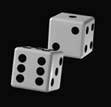

Astragalomancy, from astragalos, a Greek word referring to the knucklebone or vertebra of an animal, from which dice were originally made. A term derived from the Greek astragalos ('dice' or 'knucklebone') and manteia and applied originally to a method of telling the future from the throw of small bones (usually sheep bones), but nowadays is also applied to the throw of dice, since they were once made from bones.
In primitive times, small bones such as the vertebrae were inscribed with special divinatory symbols and used by diviners to draw answers to questions.
In another method of Astragalomancy using small bones, the bones were thrown and readings were taken from the arrangement formed upon a formal pattern or grid.
In ancient Rome, Greece and Egypt, the four-sided knucklebones of sheep were also employed in this type of divination.
Modern dice as we know are believed to have been first used by the Egyptians around 1400 BC.
Divination by dice is a fairly simple procedure. A list of twenty possible answers - numbered from four to twenty-four - must be written out. A pair of ordinary dice is then thrown and their numbers added together and written down. A second cast of the die is performed, and their numbers are added to the first. The resulting number is then matched to the corresponding answer on the numbered list. According to ancient occult tradition, Mondays, Tuesdays, Wednesdays, Thursdays and Saturdays are the most favorable days of the week for the casting of the dice. You should not attempt it on Fridays and Sundays.